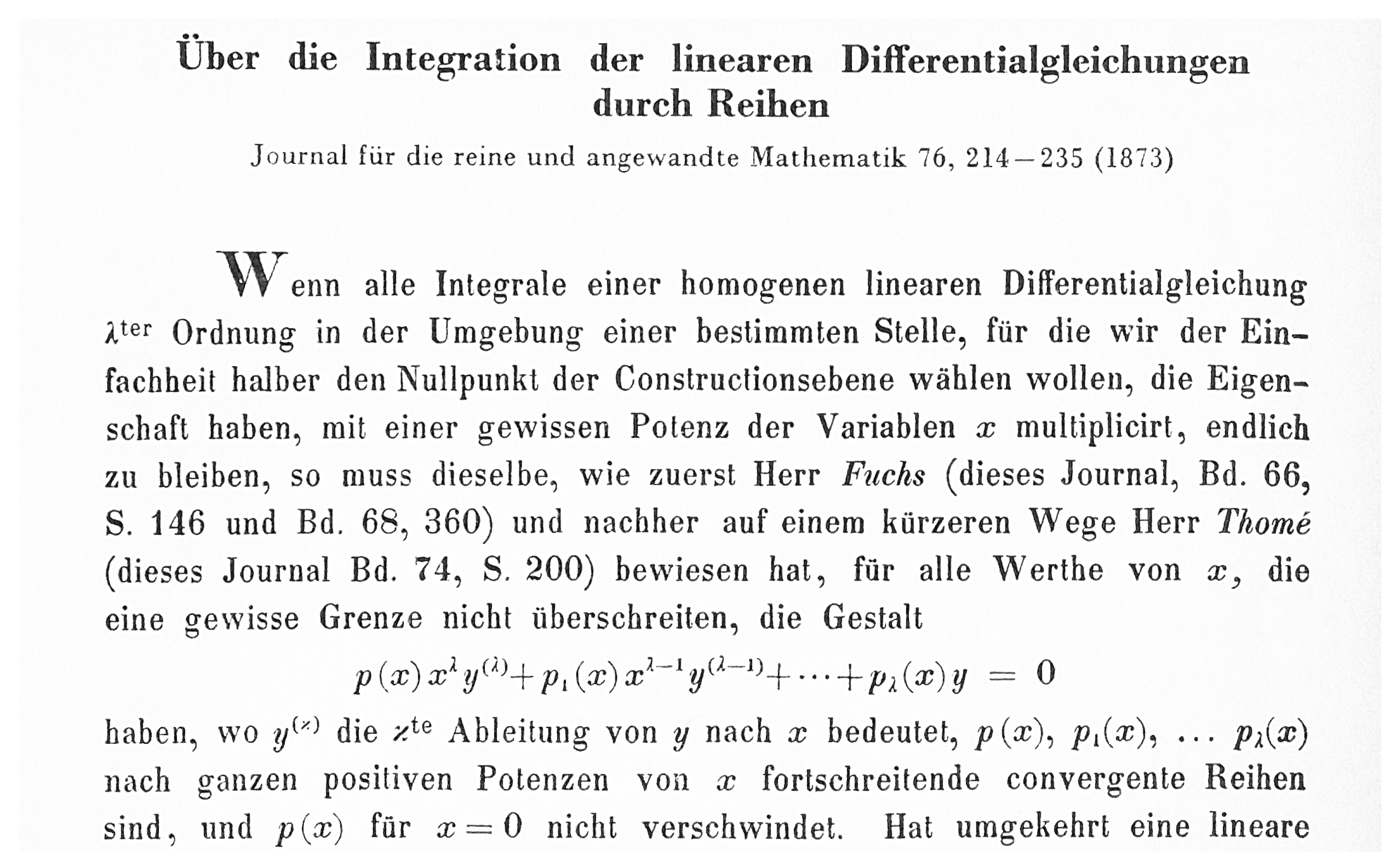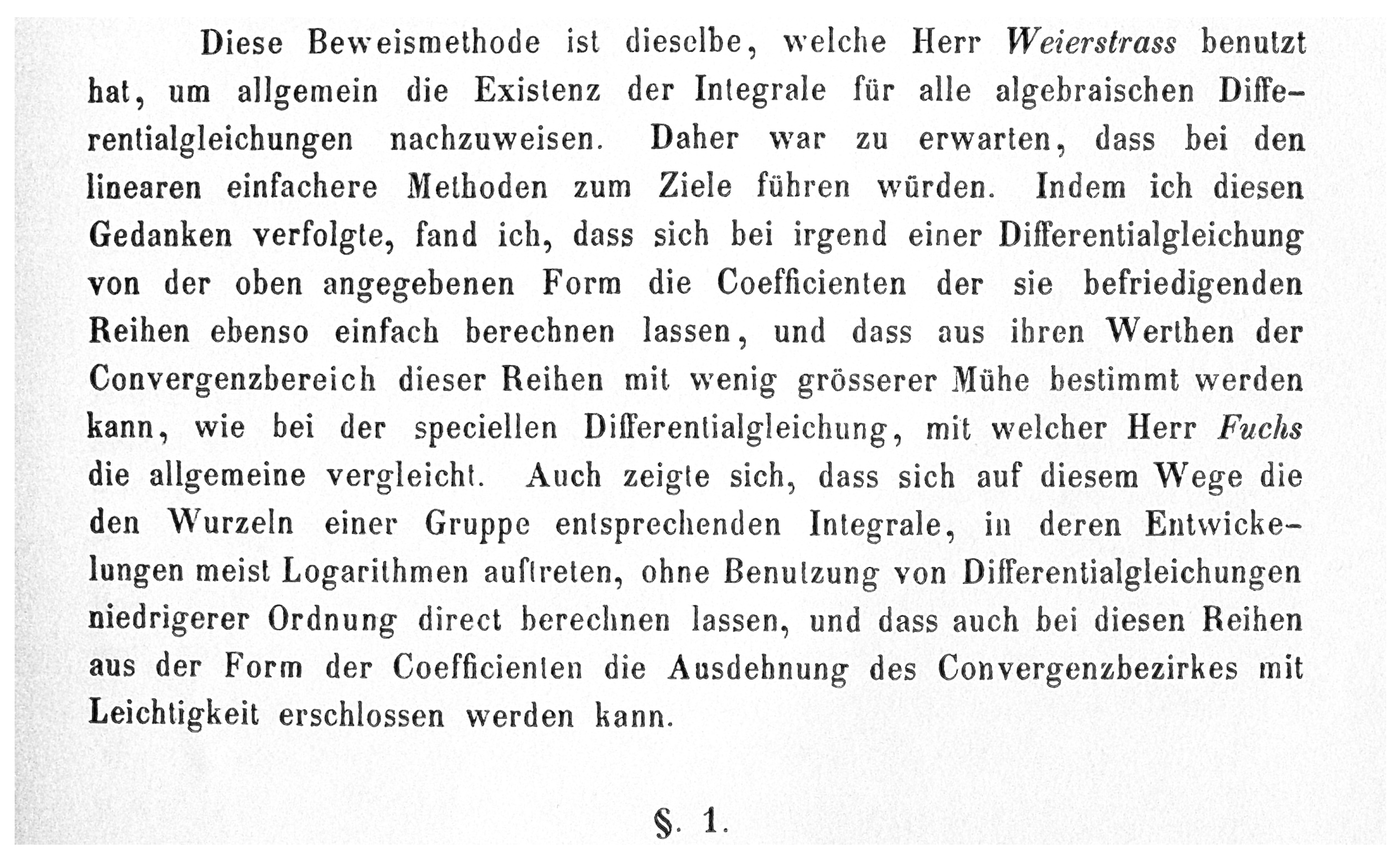Tandem Recurrence Relations for Coefficients of Logarithmic Frobenius Series Solutions about Regular Singular Points
Abstract
:1. Introduction
1.1. Subject, Problem, Main Goal and Results of This Manuscript
1.1.1. Main Subject of This Manuscript: Frobenius’ Method
1.1.2. Current Status of Frobenius’ Method and Problem Statement
1.1.3. Aim of This Manuscript
1.1.4. Main Result
1.1.5. Demonstration
1.2. Frobenius’ Method
1.2.1. Purpose of the Method; Regular Singular Points
1.2.2. Frobenius’ Ansatz and the Merits of His Approach
1.2.3. On the Results of Fuchs
1.2.4. On What Frobenius Added to the Theory of Fuchs. Enhanced -Method
1.3. Tandem Recurrence Relations Emerging from the Method
1.3.1. Relevance of Frobenius’ -Method and Our Enhancement of It
1.3.2. Current Status of -Method and Novelty of Our Enhancement
1.3.3. Merit of Our Tandem Approach
1.4. To Normalize or Not to Normalize the Coefficient of the Highest Order Derivative
1.4.1. Original Goal of the Theory
1.4.2. The Normalization Convention in Textbooks
1.4.3. Why Normalization May Induce Complication
1.4.4. Why Polynomial Coefficients Can Bring Computational Efficiency
1.5. Outline
1.5.1. Exposition of the Theory
1.5.2. Demonstration: Bessel’s Equation
1.5.3. Summary, Reflection and History
2. Analysis and Enhancement of Frobenius’ Method
2.1. Frobenius’ Expansion of the Image of the Differential Operator, First Solution of the Differential Equation and Second Solution When the Roots of the Indicial Equation Are Unequal and Do Not Differ by an Integer
2.1.1. General Expansion of the Image of the Differential Operator
2.1.2. Solution Associated with the Largest Root of the Indicial Equation
2.1.3. Second Linearly Independent Solution? Emergence of the So-Called Exceptional Cases
2.2. Conception of the Method, General Relations Central to the Method and Second Linearly Independent Solution in Case the Roots of the Indicial Equation Are Equal
2.2.1. Inspiration from the Case in Which the Roots of the Indicial Equation Are Equal
2.2.2. Frobenius’ Class of Functions and General Relations Central to the Method
2.2.3. First Application of the Method: Solutions in Case the Roots and of the Indicial Equation Are Equal
2.2.4. The Derivative of the First Recurrence Relation with Respect to Frobenius’ Parameter r
2.2.5. Tandem Recurrence Relations for Generalized Power Series Coefficients in Case
2.2.6. The Novelty of, and Enhancement Established by, the Tandem Technique
2.3. Solutions Associated with in Case
2.3.1. Structure of Indicial Polynomial
2.3.2. With and the Free Coefficient , a Solution Linearly Dependent on Is Associated
2.3.3. Second Linearly Independent Solution in Case
2.3.4. Tandem Recurrence Relations for the Coefficients
2.3.5. Why Remains a Free Parameter and the Meaning of this
2.3.6. How to Obtain , the Coefficient of the Logarithmic Factor
2.3.7. Intermediate Summary of the Method for Case
2.3.8. Possibility of Solutions Associated with without a Logarithmic Term
“(…) no modification in the definition of is necessary when (is half-integer); the real peculiarity of the solution in this case is that the negative root of the indicial equation gives rise to a series containing two arbitrary constants, i.e., to the general solution of the differential equation.”
2.3.9. Conclusions
3. Application: Series Solutions for Bessel’s Equation
3.1. Coefficients and Indicial Polynomial
3.2. Minimal Value of n for the Recurrence Relations to Be Form Invariant
3.3. Recurrence Relations for
3.4. Recurrence Relations for and
3.5. Results Relevant to Bessel Functions of the Second Kind
3.5.1. Distinct Roots of the Indicial Equation, Not Differing by an Integer
3.5.2. Two Equal Roots: Bessel Equation of Order Zero
3.5.3. Bessel Equations of Integer or Half-Integer Order Larger than Zero
4. Discussion
4.1. Synopsis and Goal of Further Discussion
4.2. Historical Origin and Background
- The standardization of the differential equation by normalizing the pre-factor of to be . In addition, see Figure 2.
- The Ansatz (5), inspired by the earlier results of Fuchs, to look for solutions in the form of generalized power series, while this generalization introduces no more than only a single parameter r. This parameter is used to shift the powers of the variable x in the power series, all by the same amount.
- Frobenius’ discovery that, at least for a first series solution, the coefficients of the series obey a recurrence relation that can be derived quite simply (“einfach”, see Figure 3).
- The idea that then all coefficients of the series may be conceived as functions of r, too.
- As an attempt to construct solutions associated with a second root, , of the indicial equation, in cases of roots and being equal or differing by an integer, Frobenius explored the consequences of choosing the leading coefficient such that a division by zero in recurrence relations for the would be replaced by a limit process, , so as to obtain finite values for all coefficients . That is, in our phrasing, Frobenius explored the option to haveinstead of e.g., .
- Frobenius’ idea that by means of differentiation with respect to r, new solutions of the differential equation can be obtained.
4.3. The Role and History of the Factor in the Literature
5. Conclusions
Funding
Acknowledgments
Conflicts of Interest
References
- Forsyth, A.R. A Treatise on Differential Equations; MacMillan and Co, Limited: New York, NY, USA, 1903. [Google Scholar]
- Coddington, E.A. An Introduction to Ordinary Differential Equations; Prentice-Hall: Hoboken, NJ, USA, 1961. [Google Scholar]
- Boyce, W.E.; DiPrima, R.C. Elementary Differential Equations and Boundary Value Problems, 11th ed.; Wiley: Hoboken, NJ, USA, 2013; Chapter 5.6. [Google Scholar]
- Watson, G. A Treatise on the Theory of Bessel Functions; Cambridge University Press: Cambridge, UK, 1944. [Google Scholar]
- Goode, S.; Annin, S. Differential Equations and Linear Algebra; Pearson: London, UK, 2014. [Google Scholar]
- Frobenius, F.G. Über die Integration der linearen Differentialgleichungen durch Reihen. In Gesammelte Abhandlungen; Serre, J.P., Ed.; Springer: Berlin/Heidelberg, Germany, 1968; Volume 1, pp. 84–105. [Google Scholar]
- Ince, E. Ordinary Differential Equations; Longmans, Green and Co., Ltd.: London, UK, 1927. [Google Scholar]
- Coddington, E.A.; Levinson, N. Theory of Ordinary Differential Equations; Int. Series in Pure and Applied Mathematics; McGraw-Hill: New York, NY, USA, 1955. [Google Scholar]
- Butkov, E. Mathematical Physics; Addison-Wesley: Boston, MA, USA, 1968. [Google Scholar]
- Brannan, J.R.; Boyce, W.E. Differential Equations, with Boundary Value Problems, 2nd ed.; Wiley: Hoboken, NJ, USA, 2011; Chapter 8.6. [Google Scholar]
- Fuchs, L.I. Zur Theorie der linearen Differentialgleichungen mit veränderlichen Coefficienten. In Gesammelte Mathematische Werke von L. Fuchs; Fuchs, R., Schlesinger, L., Eds.; University of Michigan Library: Berlin, Germany, 1865; Volume I, Chapter Jahrsber. Gewerbeschule; pp. 111–158. [Google Scholar]
- Fuchs, L.I. Zur Theorie der linearen Differentialgleichungen mit veränderlichen Coefficienten. J. Reine Angew. Math. 1866, 66, 159–204. [Google Scholar]
- van der Toorn, R. The Singularity of Legendre Functions of the First Kind as a Consequence of the Symmetry of Legendre’s Equation. Symmetry 2022, 14, 741. [Google Scholar] [CrossRef]
- Thomé, L.W. Zur Theorie der Linearen Differentialgleichungen. J. Reine Angew. Math. 1872, 74, 193–217. [Google Scholar]
- Gray, J. Linear Differential Equations and Group Theory from Riemann to Poincaré; Birkhäuser: Boston, MA, USA, 1986; ISBN 0-8176-3318-9. [Google Scholar]
- Abramowitz, M.; Stegun, I.A. Handbook of Mathematical Functions; Dover: New York, NY, USA, 1964. [Google Scholar]



Disclaimer/Publisher’s Note: The statements, opinions and data contained in all publications are solely those of the individual author(s) and contributor(s) and not of MDPI and/or the editor(s). MDPI and/or the editor(s) disclaim responsibility for any injury to people or property resulting from any ideas, methods, instructions or products referred to in the content. |
© 2022 by the author. Licensee MDPI, Basel, Switzerland. This article is an open access article distributed under the terms and conditions of the Creative Commons Attribution (CC BY) license (https://creativecommons.org/licenses/by/4.0/).
Share and Cite
van der Toorn, R. Tandem Recurrence Relations for Coefficients of Logarithmic Frobenius Series Solutions about Regular Singular Points. Axioms 2023, 12, 32. https://doi.org/10.3390/axioms12010032
van der Toorn R. Tandem Recurrence Relations for Coefficients of Logarithmic Frobenius Series Solutions about Regular Singular Points. Axioms. 2023; 12(1):32. https://doi.org/10.3390/axioms12010032
Chicago/Turabian Stylevan der Toorn, Ramses. 2023. "Tandem Recurrence Relations for Coefficients of Logarithmic Frobenius Series Solutions about Regular Singular Points" Axioms 12, no. 1: 32. https://doi.org/10.3390/axioms12010032
APA Stylevan der Toorn, R. (2023). Tandem Recurrence Relations for Coefficients of Logarithmic Frobenius Series Solutions about Regular Singular Points. Axioms, 12(1), 32. https://doi.org/10.3390/axioms12010032







